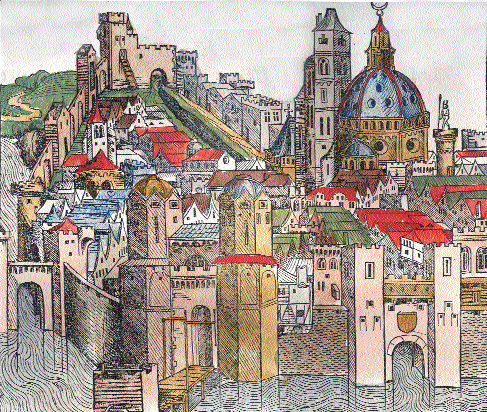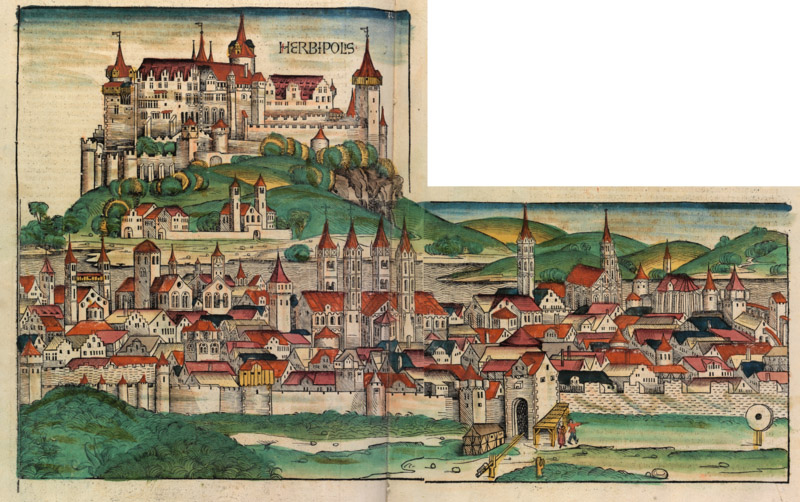
During his lifetime, the Dominican friar, bishop, and professor Albert was already known as an "astonishing wonder" of his time on account of his universal learning. Even Roger Bacon, who was immensely critical of his contemporaries, had to admit that the whole world esteemed and respected this man.
Accordingly, Albert is known by the honorific title, "the Great" (magnus). His literary production was indeed prodigious. He left behind over 70 works, among them multi-volume commentaries on the Sentences ![]() of Peter Lombard
of Peter Lombard ![]() (the Medieval theology textbook), on several books of the Holy Scriptures, and on all of Aristotle's works.
(the Medieval theology textbook), on several books of the Holy Scriptures, and on all of Aristotle's works.
The life of this universal genius began around the year 1200 in the small Schwabian town of Launigen, on the Donau river in Germany. He was the son of a noble, who held an administrative position in the kingdom. Albert himself was named after his birthplace, "Albert of Lauingen" (Albertus de Lauinga). While he was a professor in Paris, he was called "Albert the German" (Albertus Teutonicus). Albert was never, however, called the "Count [Graf] from Bollstädt", as we sometimes read.
We know the date of his death precisely: It was November 15, 1280. Albert reached an unusually old age for the time. He died, as it says in the reports, at over 80 years of age in his adopted home of Cologne, Germany, where he spent his twilight years after a very active life.

The city of Padua : Nurenberg Chronicle ![]()
Years of Study
As a young man, Albert was sent by his family in 1222 to live with an uncle in Padua ![]() , to study there. There, he met the Dominican Jordan of Saxony
, to study there. There, he met the Dominican Jordan of Saxony ![]() and entered the Order in 1223.
and entered the Order in 1223.
Established in 1214 in Toulouse, France, and recognized by the Catholic Church in 1216, the Dominican Order was the most modern and open to science of the religious orders in its time. It offered many opportunities for a curious and highly intelligent young man like Albert.
We know few details about the next few years of Albert's life, but his first activities as a learned man in the order were at
- Cologne
- Hildesheim
- Freiburg
- Regensburg
- Straßburg
Years of Teaching
The Dominican Order sent Albert to the University of Paris at the relatively old age of 43, to become a Professor of Theology. Paris was at that time the most important university in Europe. The Parisian Convent of the Dominicans, St. Jacques ![]() , offered opportunities to research and learn with other Dominicans from all over Europe. Albert was so beloved as a professor that he had to give his lectures in a public place. This place is still named "Place Maubert"
, offered opportunities to research and learn with other Dominicans from all over Europe. Albert was so beloved as a professor that he had to give his lectures in a public place. This place is still named "Place Maubert" ![]() after him (From the French: "Ma," for Magister and "Aubert" for Albertus).
after him (From the French: "Ma," for Magister and "Aubert" for Albertus).
Paris was, however, only a step along Albert's career path. In 1248, the head of the order sent him to Cologne to found a university modeled after the university in Paris. He brought a student with him to Cologne whom he had met and grown to like in Paris - a student whose name would later place Albert's own in the shadows: Thomas Aquinas.
A European Traveler, At Home in Cologne
Cologne was the only city in Europe to which Albert remained attached until the end of his life. Several times, during political crises, he inserted himself as a mediator for the residents of his adopted home. But Albert could not be said to have been completely settled. In accordance with the custom of his order ![]() , he traveled by foot through all of Europe in service to the order and the church, from Agiani (in present-day Georgia) to Riga (in present-day Lithuania). From 1254-1257 he was active in the order's operations as the provincial administrator of "Teutonia" (most of modern Germany). During this time he visited over 40 houses of his order.
, he traveled by foot through all of Europe in service to the order and the church, from Agiani (in present-day Georgia) to Riga (in present-day Lithuania). From 1254-1257 he was active in the order's operations as the provincial administrator of "Teutonia" (most of modern Germany). During this time he visited over 40 houses of his order.
Bishop "Tied-Shoe"
From 1260-1262, on the Pope's orders and against the will of the leader of his order, who would rather have seen Albert dead than honored in that way, Albert was named Bishop of Regensburg and thus a Prince-Elector ![]() of the region. Despite his elevation, however, Albert remained true to the simple life of a beggar-monk. In his diocese, he received the playful name of "tied shoe,"
of the region. Despite his elevation, however, Albert remained true to the simple life of a beggar-monk. In his diocese, he received the playful name of "tied shoe," ![]() because he was always on foot when he visited the parishes. Within two years he succeeded in reviving the financially ailing diocese. He then asked to be allowed to withdraw from his office. He received special permission despite his vow of poverty to own books and a bishop's robes, have some money, and to have the right to take on the liturgical duties of a bishop until the end of his life.
because he was always on foot when he visited the parishes. Within two years he succeeded in reviving the financially ailing diocese. He then asked to be allowed to withdraw from his office. He received special permission despite his vow of poverty to own books and a bishop's robes, have some money, and to have the right to take on the liturgical duties of a bishop until the end of his life.
Universally Learned
How Albert managed to write so many books alongside his official duties and travels is hard to explain. Some, like his book On Animals (De animalibus), his commentary on Aristotle's Physics (Physica) and his Commentary on Matthew (Super Matthaeum), survive today in manuscripts copied in his own hand. Their immeasurable worth as originals is not readily apparent, however, as they are inconspicuous and unadorned.
Albert's "bestsellers," works like the Book on Rocks (De mineralibus), survive today in more than a hundred copies. This is yet only a very small remainder of the total that once existed.
Albert the Scientist
Albert considerably advanced the understanding of science in the Middle Ages. He did not limit himself to what was written in dusty old books about plants, animals, minerals and metals, or natural phenomena like rainbows, comets and earthquakes. Instead, he observed the natural world himself, measured and weighed, and even performed experiments. His brothers in the Cologne monastery were shocked when a snake reeled through the cloister one day. Albert had given it wine to drink in order to see what sort of effect alcohol would have on the cold-blooded animal.
Albert was the first Western scientist to group plants and animals in accordance with their characteristics and features. In so doing he laid the foundations for the practice of classification which is now followed in biology, taxonomy. Albert especially loved observing hunting birds. He also loved observing man as an animal, blessed as he believed with a soul and reason, having vegetative, animal, and intellectual being.
Albert provided a proof that the earth had to be a sphere, since the first thing we see when a ship emerges over the horizon of the ocean is the tip of its mast. This would not be so, he argued, if the earth were a disk. Albert not only equipped himself with a copy of Euclid's Geometry -- he used it. Even before Albert became a professor in Paris, he had, as one of the most learned people in the Middle Ages, written an extensive encyclopedic work about humanity.
Deep knowledge is not witchcraft!
Some of Albert's contemporaries considered him to be a magician on account of his unusual degree of knowledge. Soon people were telling fantastic stories about him. Albert himself, however, regarded nature very soberly and always sought useful explanations and natural causes of what he observed, no matter how inexplicable something appeared to be. His approach to natural phenomena is very modern in some respects, since he did not interest himself in miracles. Within the Dominican Order, he was heavily criticized for this approach. This prompted Albert to compare his critical brethren to dumb animals who had no inkling about the things they criticized.
Albert the Philosopher
Albert's influence on the field of philosophy was also great. He was the first and only thinker of his time to write commentaries on all of the works of Aristotle. When Albert thought such a work was missing, he wrote his own as a substitute. But it was not just the number of his philosophical works which made him into an "astonishing wonder" of his time. It is also fact that he boldly countered the claims he found in the "heathen books."
Even in Albert's time there was considerable debate about taking the claims of Greek thinkers seriously, since many religious leaders doubted that an attempt should be made to reconcile Christian dogma with the teachings of Aristotle and his interpreters from the Jewish and Muslim traditions. But Albert did not shy away from the difficulties. Instead he confronted them directly, accepting what was good and right and correcting what he considered wrong.
Albert the Theologian
Albert the Great draws from the whole depth of his natural, philosophical, and theological knowledge in his major theological works:
- Commentary on Peter Lombard's Sentences
- On the writings of "Dionysius Aeropagita"
- Scriptural expositions
In old age, he wrote a plan for a theological compendium or summa, which remained unfinished at his death. Although the Summa theologica of his student, Thomas Aquinas, who predeceased him in 1247, is more highly regarded in the Dominican Order and in the Catholic church, Albert's theological works are deeply esteemed. In 1931, Albert's enormous life's achievement was recognized when he was canonized and named a doctor of the church. Since 1941 he has been recognized as the Patron Saint of Scientists.
Brush up on Albert!
Albert's writings on natural science form the basis for many encyclopedias. During the Enlightenment, Albert's enormous learning was disregarded, since he was considered medieval and therefore backward. So convince yourself of the opposite! Brush up on Albert! This "universal doctor" offers answers for almost every question.
